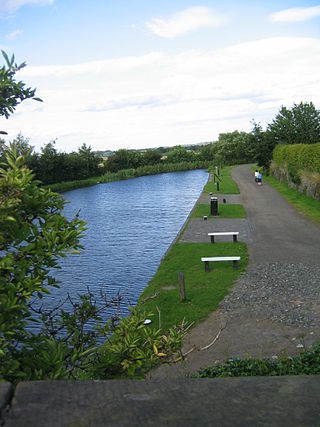
The Leeds and Liverpool Canal is a canal in Northern England, linking the cities of Leeds and Liverpool.

The Forth and Clyde Canal is a canal opened in 1790, crossing central Scotland; it provided a route for the seagoing vessels of the day between the Firth of Forth and the Firth of Clyde at the narrowest part of the Scottish Lowlands. This allowed navigation from Edinburgh on the east coast to the port of Glasgow on the west coast. The canal is 35 miles (56 km) long and it runs from the River Carron at Grangemouth to the River Clyde at Bowling, and had an important basin at Port Dundas in Glasgow.

The Wilts & Berks Canal is a canal in the historic counties of Wiltshire and Berkshire, England, linking the Kennet and Avon Canal at Semington near Melksham, to the River Thames at Abingdon. The North Wilts Canal merged with it to become a branch to the Thames and Severn Canal at Latton near Cricklade. Among professional trades boatmen, the canal was nicknamed the Ippey Cut, possibly short for Chippenham.

The Herefordshire and Gloucestershire Canal is a canal in the west of England, which ran from Hereford to Gloucester, where it linked to the River Severn. It was opened in two phases in 1798 and 1845, and closed in 1881, when the southern section was used for the course of the Ledbury and Gloucester Railway. It is the subject of an active restoration scheme.

The Dorset and Somerset Canal was a proposed canal in southwestern England. The main line was intended to link Poole, Dorset with the Kennet and Avon Canal near Bradford on Avon, Wiltshire. A branch was to go from the main line at Frome to the southern reaches of the Somerset coalfield at Nettlebridge. Construction of the branch started in 1786, using boat lifts rather than locks to cope with changes of level, but the company ran out of money and the canal was abandoned in 1803, never to be completed.

The Ashby-de-la-Zouch Canal is a 31-mile (50 km) long canal in England which connected the mining district around Moira, just outside the town of Ashby-de-la-Zouch in Leicestershire, with the Coventry Canal at Bedworth in Warwickshire. It was opened in 1804, and a number of tramways were constructed at its northern end, to service collieries. The canal was taken over by the Midland Railway in 1846, but remained profitable until the 1890s, after which it steadily declined. Around 9 miles (14 km) passed through the Leicestershire coal field, and was heavily affected by subsidence, with the result that this section from Moira, southwards to Snarestone, was progressively closed in 1944, 1957 and 1966, leaving 22 miles (35 km) of navigable canal.
Robert Taylor is the name of:
David Parker may refer to:
Robert, Rob, or Bob Stevenson may refer to:

The Foulridge Tunnel is a canal tunnel on the Leeds and Liverpool Canal in Foulridge, Lancashire. Also known as the Mile Tunnel, Foulridge is 1,630 yards long and was built by Samuel Fletcher, following Robert Whitworth's 1789 survey. The tunnel is the longest in the country to allow passage of canoes and kayaks.
Mike Roberts may refer to:
Rob(ert), Bob, or Bobby Jones may refer to:
Robert MacKenzie or similar may refer to:
The Whitworth rifle was an English-made percussion rifle used in the latter half of the 19th century. A single-shot muzzleloader with excellent long-range accuracy for its era, especially when used with a telescopic sight, the Whitworth rifle was widely regarded as the world's first sniper rifle.
Josiah Clowes (1735–1794) was an English civil engineer and canal builder. His early years were spent running a canal carrying company with Hugh Henshall, and although he worked on some canal projects before 1783, that year marked his switch to being an engineer. His first major project included the Sapperton Tunnel on the Thames and Severn Canal, which despite huge engineering difficulties, gained him a reputation which enabled him to become the first great tunnelling engineer, responsible for three of the four longest canal tunnels built.

Hugh Baird was a Scottish civil engineer, who designed and oversaw the building of the Union Canal.
William Bennet was an English civil engineer, noted for his work on canals. Nothing is known of his early life or family history, but details of his work from about 1790 until 1826 are documented. His major projects were for the Dorset and Somerset Canal and the Somersetshire Coal Canal.
Manchester is one of the principal cities of the United Kingdom, gaining city status in 1853, thus becoming the first new city in over 300 years since Bristol in 1542. Often regarded as the first industrialised city, Manchester was a city built by the Industrial Revolution and had little pre-medieval history to speak of. Manchester had a population of 10,000 in 1717, but by 1911 it had burgeoned to 2.3 million.
Robert Whitworth was an English land surveyor and engineer, who learnt his trade under John Smeaton and James Brindley, and went on to become one of the leading canal engineers of his generation.
Whitworth is an Anglo-Scottish surname. The name originated as a place name on the Anglo-Scottish Border. Particularly in Lowland Scotland. Notable people with this surname include:
This page is based on this
Wikipedia article Text is available under the
CC BY-SA 4.0 license; additional terms may apply.
Images, videos and audio are available under their respective licenses.







